COIT20248: Systems Analysis and Design - ICF Project Development
VerifiedAdded on 2023/06/09
|13
|2262
|372
Report
AI Summary
This report presents a comprehensive project plan for developing an information system for the International Charity Foundation (ICF), aiming to address operational inefficiencies like manual errors and paper-based record-keeping. The proposed system involves implementing new hardware and software, utilizing a rapid prototyping development approach, and adhering to a budget of $250,000. The report includes a detailed cost-benefit analysis, a project schedule estimating completion in approximately 85 days, and an exploration of system information requirement investigation techniques. Key aspects covered are system requirements (functional and non-functional), a work breakdown structure, and a Gantt chart for project scheduling. The report concludes with reflections on the learning experience, emphasizing the application of project management techniques and the selection of appropriate development methodologies. The document is contributed by a student and available on Desklib.
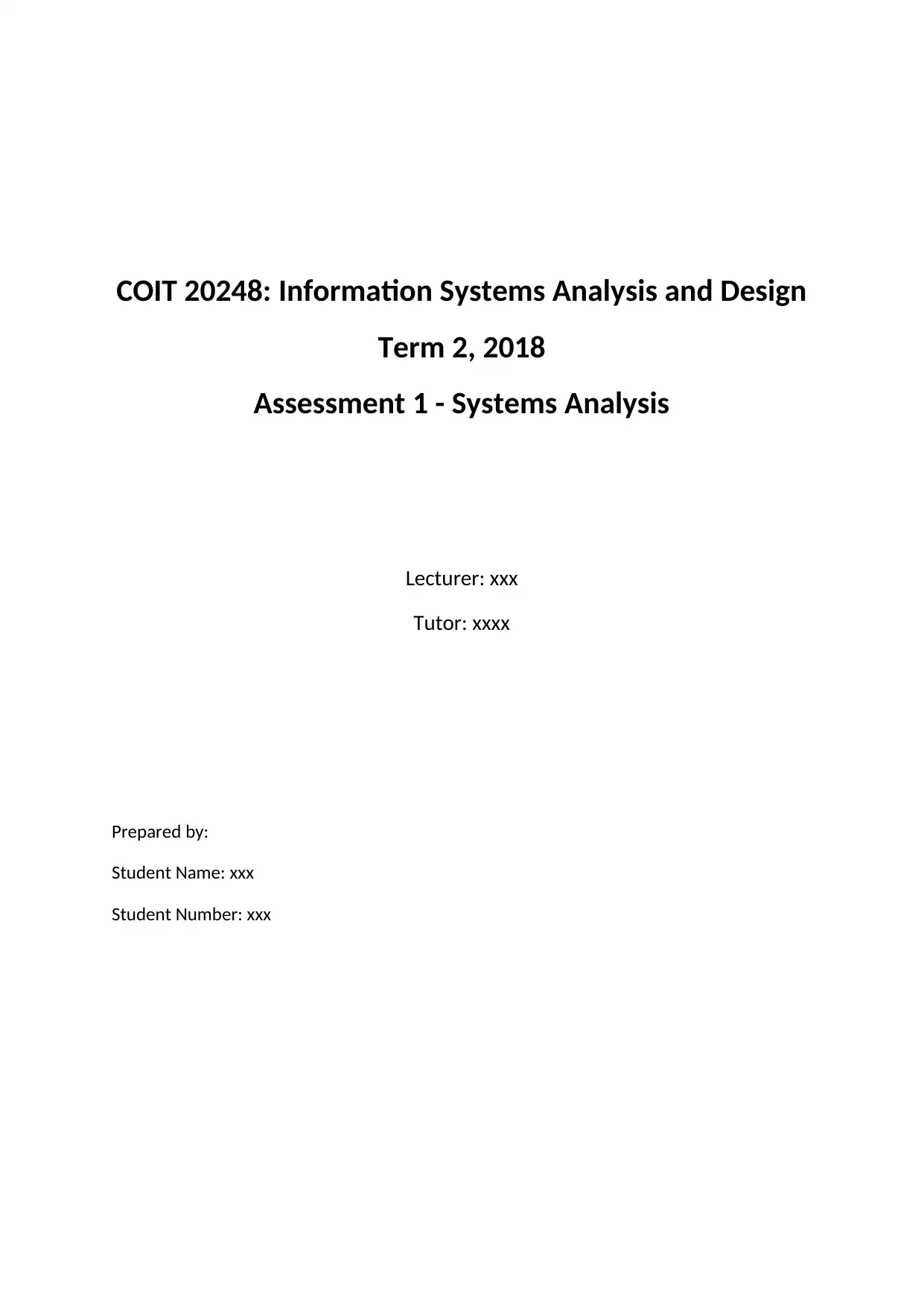
COIT 20248: Information Systems Analysis and Design
Term 2, 2018
Assessment 1 - Systems Analysis
Lecturer: xxx
Tutor: xxxx
Prepared by:
Student Name: xxx
Student Number: xxx
Term 2, 2018
Assessment 1 - Systems Analysis
Lecturer: xxx
Tutor: xxxx
Prepared by:
Student Name: xxx
Student Number: xxx
Paraphrase This Document
Need a fresh take? Get an instant paraphrase of this document with our AI Paraphraser
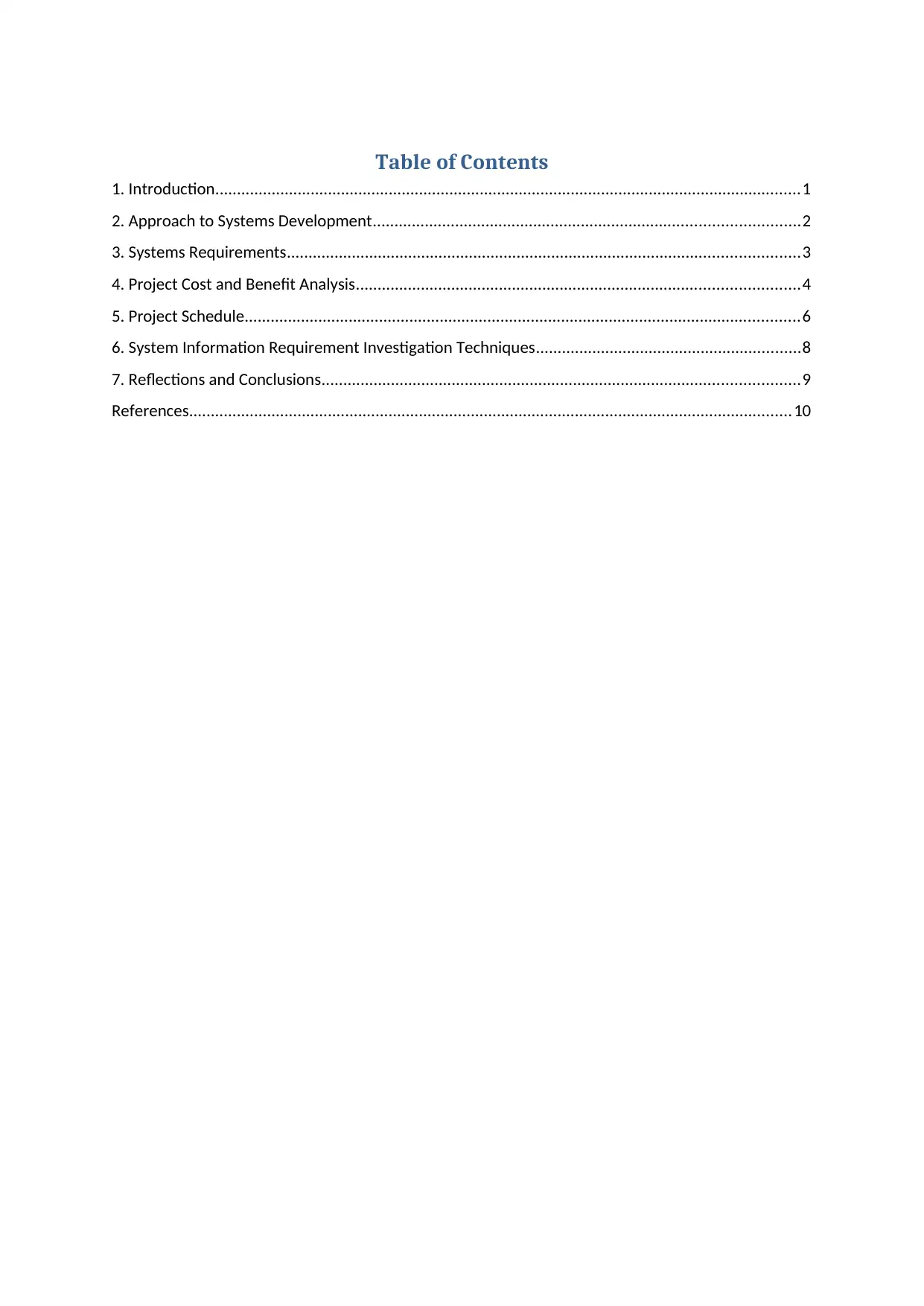
Table of Contents
1. Introduction.......................................................................................................................................1
2. Approach to Systems Development..................................................................................................2
3. Systems Requirements......................................................................................................................3
4. Project Cost and Benefit Analysis......................................................................................................4
5. Project Schedule................................................................................................................................6
6. System Information Requirement Investigation Techniques.............................................................8
7. Reflections and Conclusions..............................................................................................................9
References...........................................................................................................................................10
1. Introduction.......................................................................................................................................1
2. Approach to Systems Development..................................................................................................2
3. Systems Requirements......................................................................................................................3
4. Project Cost and Benefit Analysis......................................................................................................4
5. Project Schedule................................................................................................................................6
6. System Information Requirement Investigation Techniques.............................................................8
7. Reflections and Conclusions..............................................................................................................9
References...........................................................................................................................................10
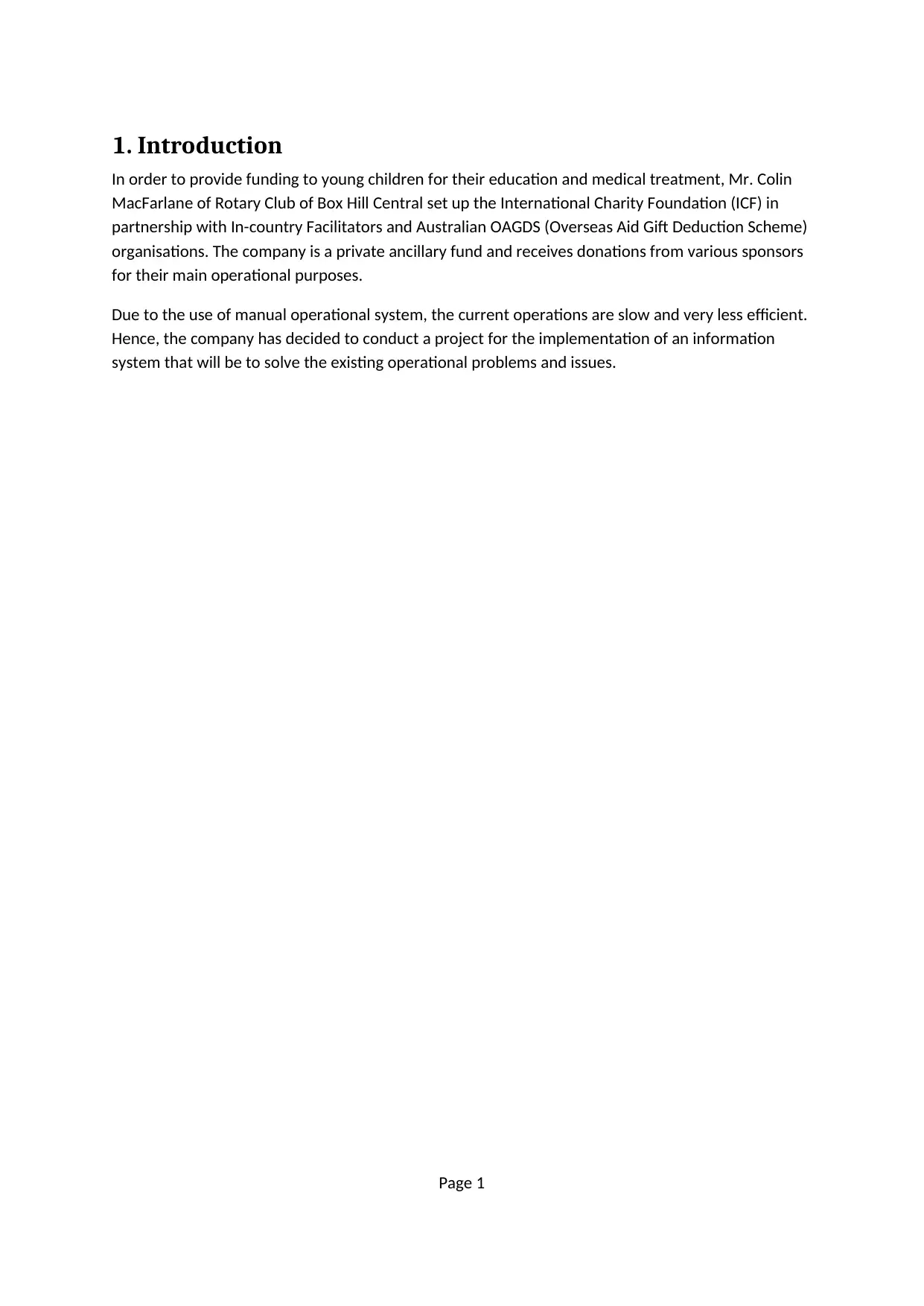
1. Introduction
In order to provide funding to young children for their education and medical treatment, Mr. Colin
MacFarlane of Rotary Club of Box Hill Central set up the International Charity Foundation (ICF) in
partnership with In-country Facilitators and Australian OAGDS (Overseas Aid Gift Deduction Scheme)
organisations. The company is a private ancillary fund and receives donations from various sponsors
for their main operational purposes.
Due to the use of manual operational system, the current operations are slow and very less efficient.
Hence, the company has decided to conduct a project for the implementation of an information
system that will be to solve the existing operational problems and issues.
Page 1
In order to provide funding to young children for their education and medical treatment, Mr. Colin
MacFarlane of Rotary Club of Box Hill Central set up the International Charity Foundation (ICF) in
partnership with In-country Facilitators and Australian OAGDS (Overseas Aid Gift Deduction Scheme)
organisations. The company is a private ancillary fund and receives donations from various sponsors
for their main operational purposes.
Due to the use of manual operational system, the current operations are slow and very less efficient.
Hence, the company has decided to conduct a project for the implementation of an information
system that will be to solve the existing operational problems and issues.
Page 1
⊘ This is a preview!⊘
Do you want full access?
Subscribe today to unlock all pages.

Trusted by 1+ million students worldwide
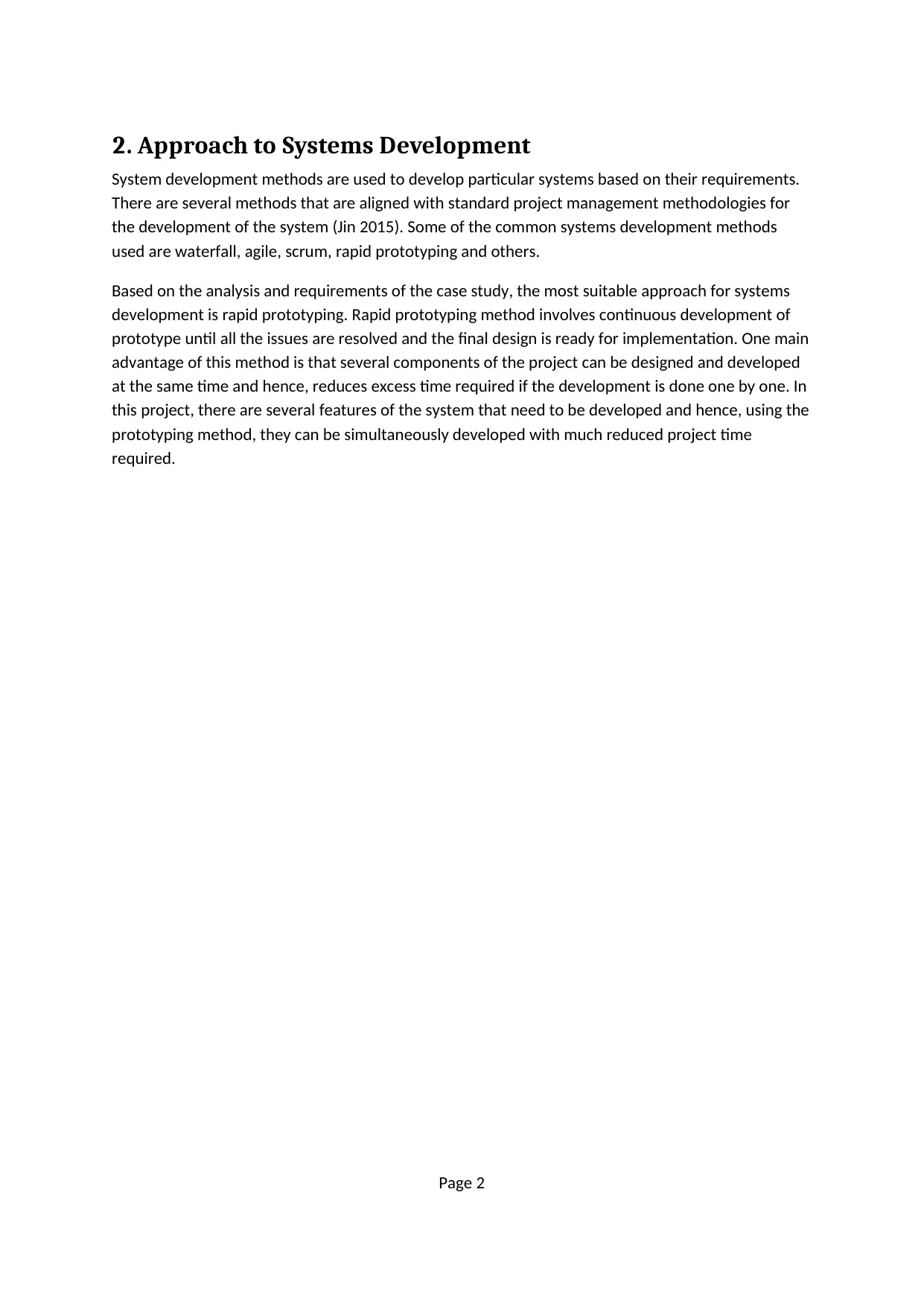
2. Approach to Systems Development
System development methods are used to develop particular systems based on their requirements.
There are several methods that are aligned with standard project management methodologies for
the development of the system (Jin 2015). Some of the common systems development methods
used are waterfall, agile, scrum, rapid prototyping and others.
Based on the analysis and requirements of the case study, the most suitable approach for systems
development is rapid prototyping. Rapid prototyping method involves continuous development of
prototype until all the issues are resolved and the final design is ready for implementation. One main
advantage of this method is that several components of the project can be designed and developed
at the same time and hence, reduces excess time required if the development is done one by one. In
this project, there are several features of the system that need to be developed and hence, using the
prototyping method, they can be simultaneously developed with much reduced project time
required.
Page 2
System development methods are used to develop particular systems based on their requirements.
There are several methods that are aligned with standard project management methodologies for
the development of the system (Jin 2015). Some of the common systems development methods
used are waterfall, agile, scrum, rapid prototyping and others.
Based on the analysis and requirements of the case study, the most suitable approach for systems
development is rapid prototyping. Rapid prototyping method involves continuous development of
prototype until all the issues are resolved and the final design is ready for implementation. One main
advantage of this method is that several components of the project can be designed and developed
at the same time and hence, reduces excess time required if the development is done one by one. In
this project, there are several features of the system that need to be developed and hence, using the
prototyping method, they can be simultaneously developed with much reduced project time
required.
Page 2
Paraphrase This Document
Need a fresh take? Get an instant paraphrase of this document with our AI Paraphraser
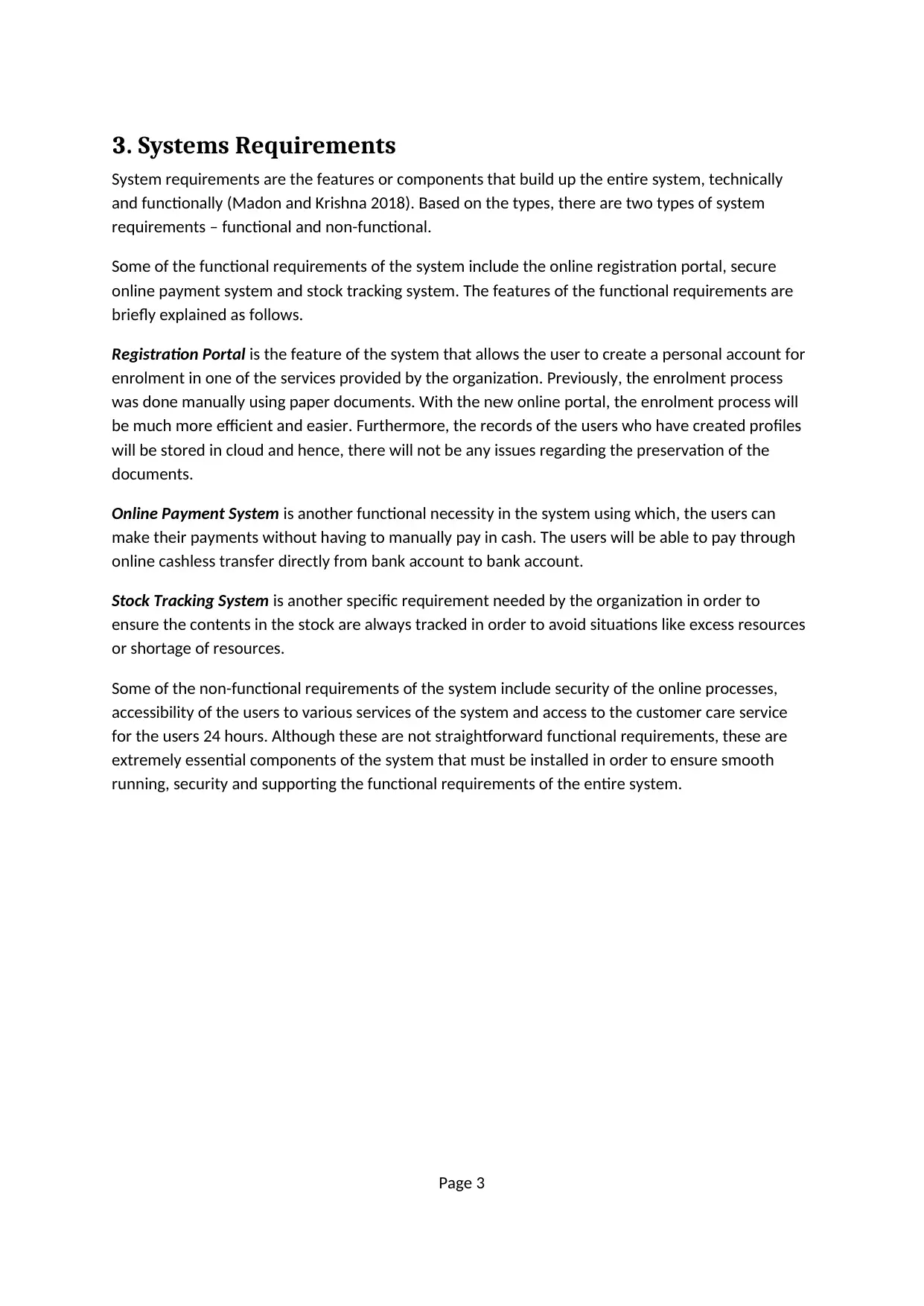
3. Systems Requirements
System requirements are the features or components that build up the entire system, technically
and functionally (Madon and Krishna 2018). Based on the types, there are two types of system
requirements – functional and non-functional.
Some of the functional requirements of the system include the online registration portal, secure
online payment system and stock tracking system. The features of the functional requirements are
briefly explained as follows.
Registration Portal is the feature of the system that allows the user to create a personal account for
enrolment in one of the services provided by the organization. Previously, the enrolment process
was done manually using paper documents. With the new online portal, the enrolment process will
be much more efficient and easier. Furthermore, the records of the users who have created profiles
will be stored in cloud and hence, there will not be any issues regarding the preservation of the
documents.
Online Payment System is another functional necessity in the system using which, the users can
make their payments without having to manually pay in cash. The users will be able to pay through
online cashless transfer directly from bank account to bank account.
Stock Tracking System is another specific requirement needed by the organization in order to
ensure the contents in the stock are always tracked in order to avoid situations like excess resources
or shortage of resources.
Some of the non-functional requirements of the system include security of the online processes,
accessibility of the users to various services of the system and access to the customer care service
for the users 24 hours. Although these are not straightforward functional requirements, these are
extremely essential components of the system that must be installed in order to ensure smooth
running, security and supporting the functional requirements of the entire system.
Page 3
System requirements are the features or components that build up the entire system, technically
and functionally (Madon and Krishna 2018). Based on the types, there are two types of system
requirements – functional and non-functional.
Some of the functional requirements of the system include the online registration portal, secure
online payment system and stock tracking system. The features of the functional requirements are
briefly explained as follows.
Registration Portal is the feature of the system that allows the user to create a personal account for
enrolment in one of the services provided by the organization. Previously, the enrolment process
was done manually using paper documents. With the new online portal, the enrolment process will
be much more efficient and easier. Furthermore, the records of the users who have created profiles
will be stored in cloud and hence, there will not be any issues regarding the preservation of the
documents.
Online Payment System is another functional necessity in the system using which, the users can
make their payments without having to manually pay in cash. The users will be able to pay through
online cashless transfer directly from bank account to bank account.
Stock Tracking System is another specific requirement needed by the organization in order to
ensure the contents in the stock are always tracked in order to avoid situations like excess resources
or shortage of resources.
Some of the non-functional requirements of the system include security of the online processes,
accessibility of the users to various services of the system and access to the customer care service
for the users 24 hours. Although these are not straightforward functional requirements, these are
extremely essential components of the system that must be installed in order to ensure smooth
running, security and supporting the functional requirements of the entire system.
Page 3
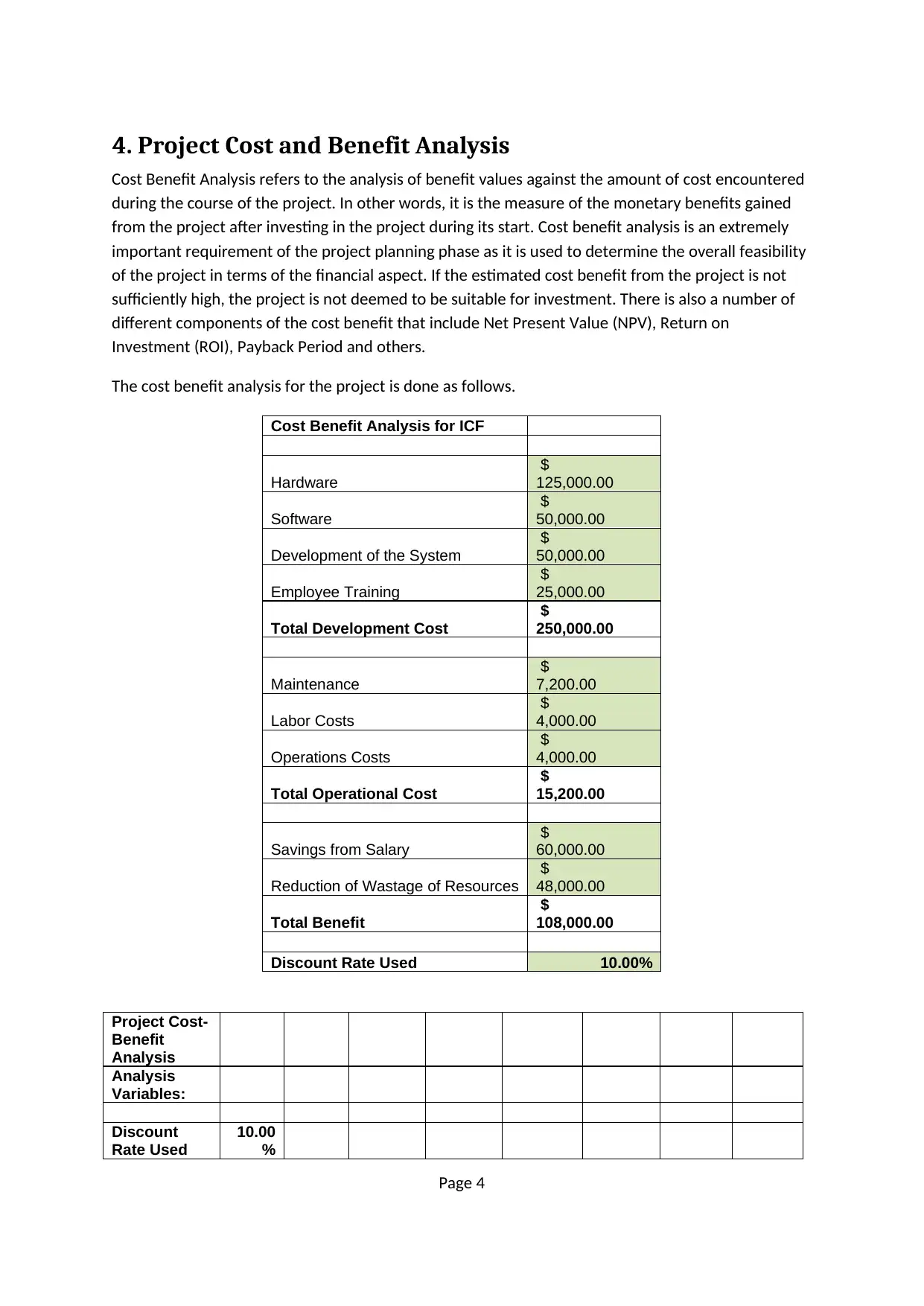
4. Project Cost and Benefit Analysis
Cost Benefit Analysis refers to the analysis of benefit values against the amount of cost encountered
during the course of the project. In other words, it is the measure of the monetary benefits gained
from the project after investing in the project during its start. Cost benefit analysis is an extremely
important requirement of the project planning phase as it is used to determine the overall feasibility
of the project in terms of the financial aspect. If the estimated cost benefit from the project is not
sufficiently high, the project is not deemed to be suitable for investment. There is also a number of
different components of the cost benefit that include Net Present Value (NPV), Return on
Investment (ROI), Payback Period and others.
The cost benefit analysis for the project is done as follows.
Cost Benefit Analysis for ICF
Hardware
$
125,000.00
Software
$
50,000.00
Development of the System
$
50,000.00
Employee Training
$
25,000.00
Total Development Cost
$
250,000.00
Maintenance
$
7,200.00
Labor Costs
$
4,000.00
Operations Costs
$
4,000.00
Total Operational Cost
$
15,200.00
Savings from Salary
$
60,000.00
Reduction of Wastage of Resources
$
48,000.00
Total Benefit
$
108,000.00
Discount Rate Used 10.00%
Project Cost-
Benefit
Analysis
Analysis
Variables:
Discount
Rate Used
10.00
%
Page 4
Cost Benefit Analysis refers to the analysis of benefit values against the amount of cost encountered
during the course of the project. In other words, it is the measure of the monetary benefits gained
from the project after investing in the project during its start. Cost benefit analysis is an extremely
important requirement of the project planning phase as it is used to determine the overall feasibility
of the project in terms of the financial aspect. If the estimated cost benefit from the project is not
sufficiently high, the project is not deemed to be suitable for investment. There is also a number of
different components of the cost benefit that include Net Present Value (NPV), Return on
Investment (ROI), Payback Period and others.
The cost benefit analysis for the project is done as follows.
Cost Benefit Analysis for ICF
Hardware
$
125,000.00
Software
$
50,000.00
Development of the System
$
50,000.00
Employee Training
$
25,000.00
Total Development Cost
$
250,000.00
Maintenance
$
7,200.00
Labor Costs
$
4,000.00
Operations Costs
$
4,000.00
Total Operational Cost
$
15,200.00
Savings from Salary
$
60,000.00
Reduction of Wastage of Resources
$
48,000.00
Total Benefit
$
108,000.00
Discount Rate Used 10.00%
Project Cost-
Benefit
Analysis
Analysis
Variables:
Discount
Rate Used
10.00
%
Page 4
⊘ This is a preview!⊘
Do you want full access?
Subscribe today to unlock all pages.

Trusted by 1+ million students worldwide
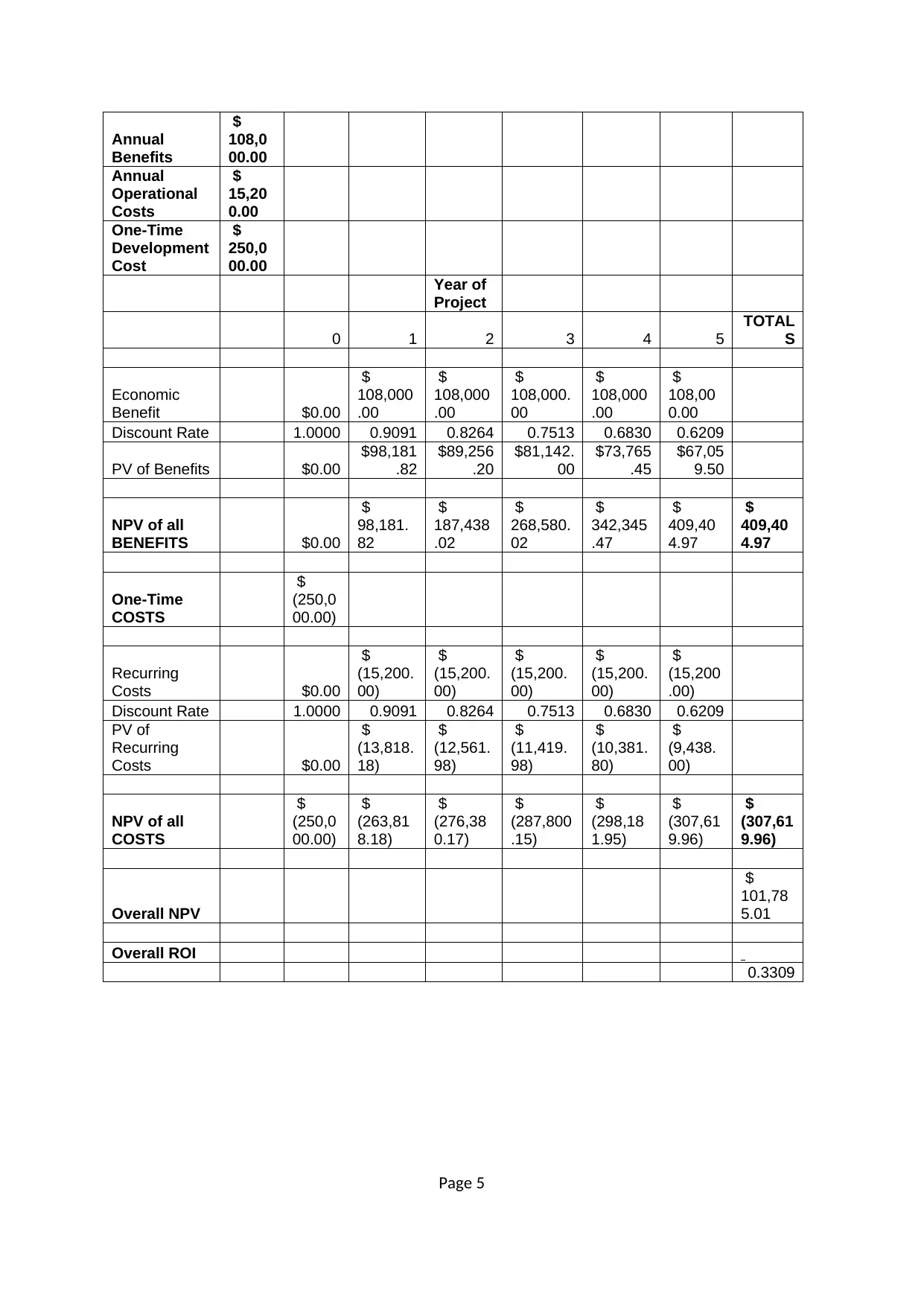
Annual
Benefits
$
108,0
00.00
Annual
Operational
Costs
$
15,20
0.00
One-Time
Development
Cost
$
250,0
00.00
Year of
Project
0 1 2 3 4 5
TOTAL
S
Economic
Benefit $0.00
$
108,000
.00
$
108,000
.00
$
108,000.
00
$
108,000
.00
$
108,00
0.00
Discount Rate 1.0000 0.9091 0.8264 0.7513 0.6830 0.6209
PV of Benefits $0.00
$98,181
.82
$89,256
.20
$81,142.
00
$73,765
.45
$67,05
9.50
NPV of all
BENEFITS $0.00
$
98,181.
82
$
187,438
.02
$
268,580.
02
$
342,345
.47
$
409,40
4.97
$
409,40
4.97
One-Time
COSTS
$
(250,0
00.00)
Recurring
Costs $0.00
$
(15,200.
00)
$
(15,200.
00)
$
(15,200.
00)
$
(15,200.
00)
$
(15,200
.00)
Discount Rate 1.0000 0.9091 0.8264 0.7513 0.6830 0.6209
PV of
Recurring
Costs $0.00
$
(13,818.
18)
$
(12,561.
98)
$
(11,419.
98)
$
(10,381.
80)
$
(9,438.
00)
NPV of all
COSTS
$
(250,0
00.00)
$
(263,81
8.18)
$
(276,38
0.17)
$
(287,800
.15)
$
(298,18
1.95)
$
(307,61
9.96)
$
(307,61
9.96)
Overall NPV
$
101,78
5.01
Overall ROI
0.3309
Page 5
Benefits
$
108,0
00.00
Annual
Operational
Costs
$
15,20
0.00
One-Time
Development
Cost
$
250,0
00.00
Year of
Project
0 1 2 3 4 5
TOTAL
S
Economic
Benefit $0.00
$
108,000
.00
$
108,000
.00
$
108,000.
00
$
108,000
.00
$
108,00
0.00
Discount Rate 1.0000 0.9091 0.8264 0.7513 0.6830 0.6209
PV of Benefits $0.00
$98,181
.82
$89,256
.20
$81,142.
00
$73,765
.45
$67,05
9.50
NPV of all
BENEFITS $0.00
$
98,181.
82
$
187,438
.02
$
268,580.
02
$
342,345
.47
$
409,40
4.97
$
409,40
4.97
One-Time
COSTS
$
(250,0
00.00)
Recurring
Costs $0.00
$
(15,200.
00)
$
(15,200.
00)
$
(15,200.
00)
$
(15,200.
00)
$
(15,200
.00)
Discount Rate 1.0000 0.9091 0.8264 0.7513 0.6830 0.6209
PV of
Recurring
Costs $0.00
$
(13,818.
18)
$
(12,561.
98)
$
(11,419.
98)
$
(10,381.
80)
$
(9,438.
00)
NPV of all
COSTS
$
(250,0
00.00)
$
(263,81
8.18)
$
(276,38
0.17)
$
(287,800
.15)
$
(298,18
1.95)
$
(307,61
9.96)
$
(307,61
9.96)
Overall NPV
$
101,78
5.01
Overall ROI
0.3309
Page 5
Paraphrase This Document
Need a fresh take? Get an instant paraphrase of this document with our AI Paraphraser
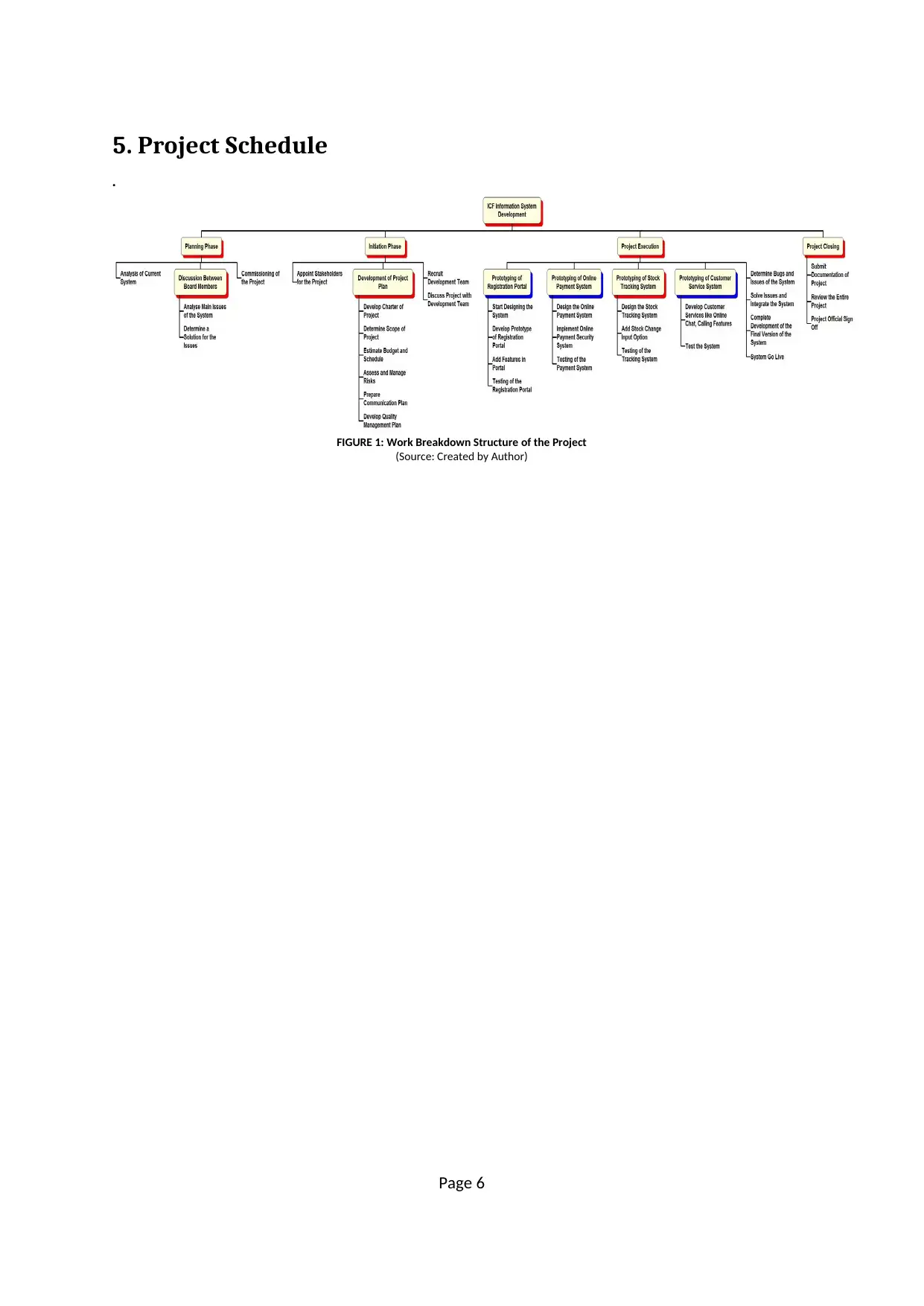
5. Project Schedule
.
FIGURE 1: Work Breakdown Structure of the Project
(Source: Created by Author)
Page 6
.
FIGURE 1: Work Breakdown Structure of the Project
(Source: Created by Author)
Page 6
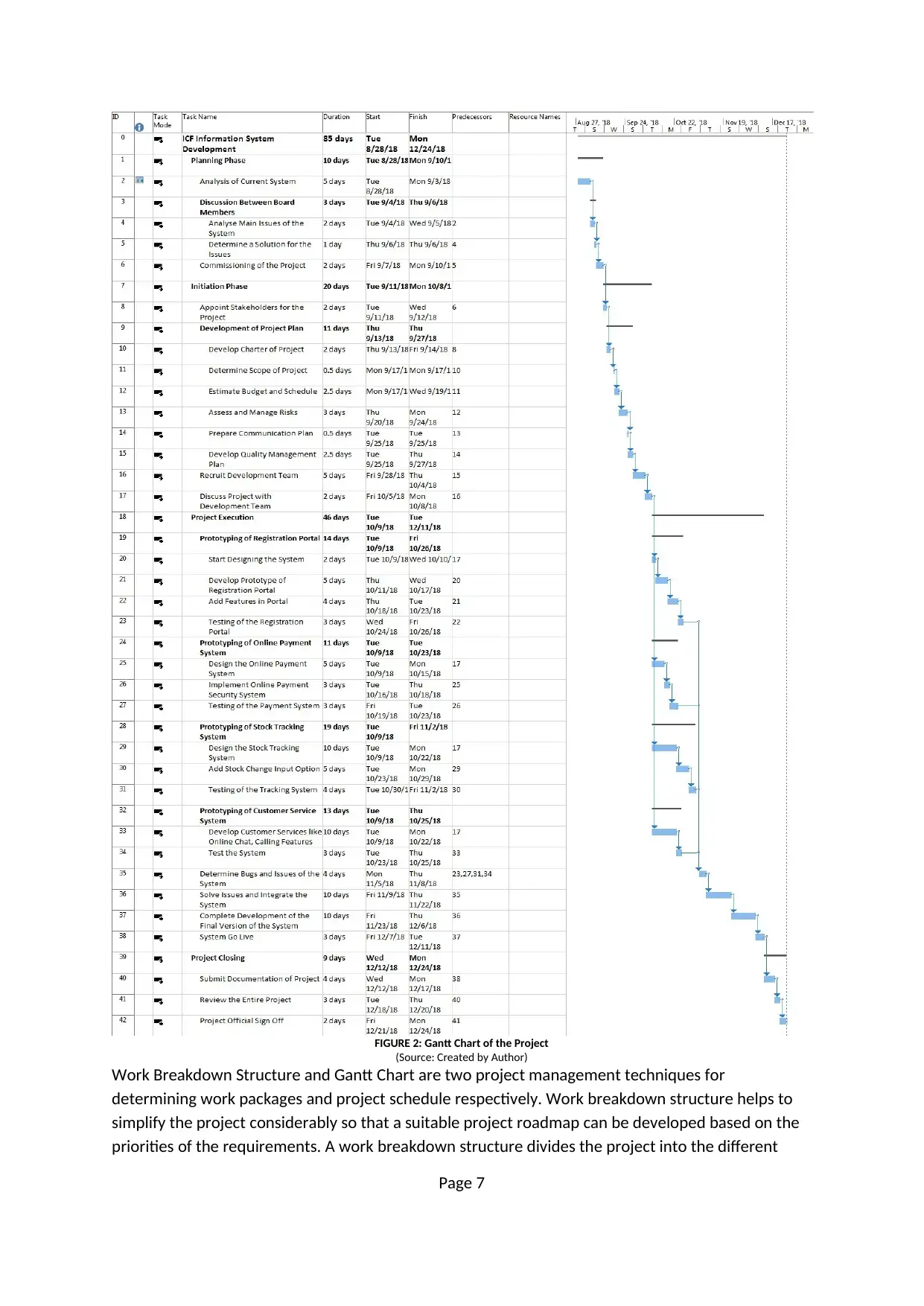
FIGURE 2: Gantt Chart of the Project
(Source: Created by Author)
Work Breakdown Structure and Gantt Chart are two project management techniques for
determining work packages and project schedule respectively. Work breakdown structure helps to
simplify the project considerably so that a suitable project roadmap can be developed based on the
priorities of the requirements. A work breakdown structure divides the project into the different
Page 7
(Source: Created by Author)
Work Breakdown Structure and Gantt Chart are two project management techniques for
determining work packages and project schedule respectively. Work breakdown structure helps to
simplify the project considerably so that a suitable project roadmap can be developed based on the
priorities of the requirements. A work breakdown structure divides the project into the different
Page 7
⊘ This is a preview!⊘
Do you want full access?
Subscribe today to unlock all pages.

Trusted by 1+ million students worldwide

phases each of which contains the sub-deliverables that in turn contain the project work packages.
On the other hand, a Gantt chart uses the links between the work packages in the work breakdown
structure, arranges the work packages in terms of priority and then estimates an overall time
schedule required to complete the project. Gantt chart also significantly helps to determine the
estimated cost in the project using the bottom up estimation technique.
Page 8
On the other hand, a Gantt chart uses the links between the work packages in the work breakdown
structure, arranges the work packages in terms of priority and then estimates an overall time
schedule required to complete the project. Gantt chart also significantly helps to determine the
estimated cost in the project using the bottom up estimation technique.
Page 8
Paraphrase This Document
Need a fresh take? Get an instant paraphrase of this document with our AI Paraphraser
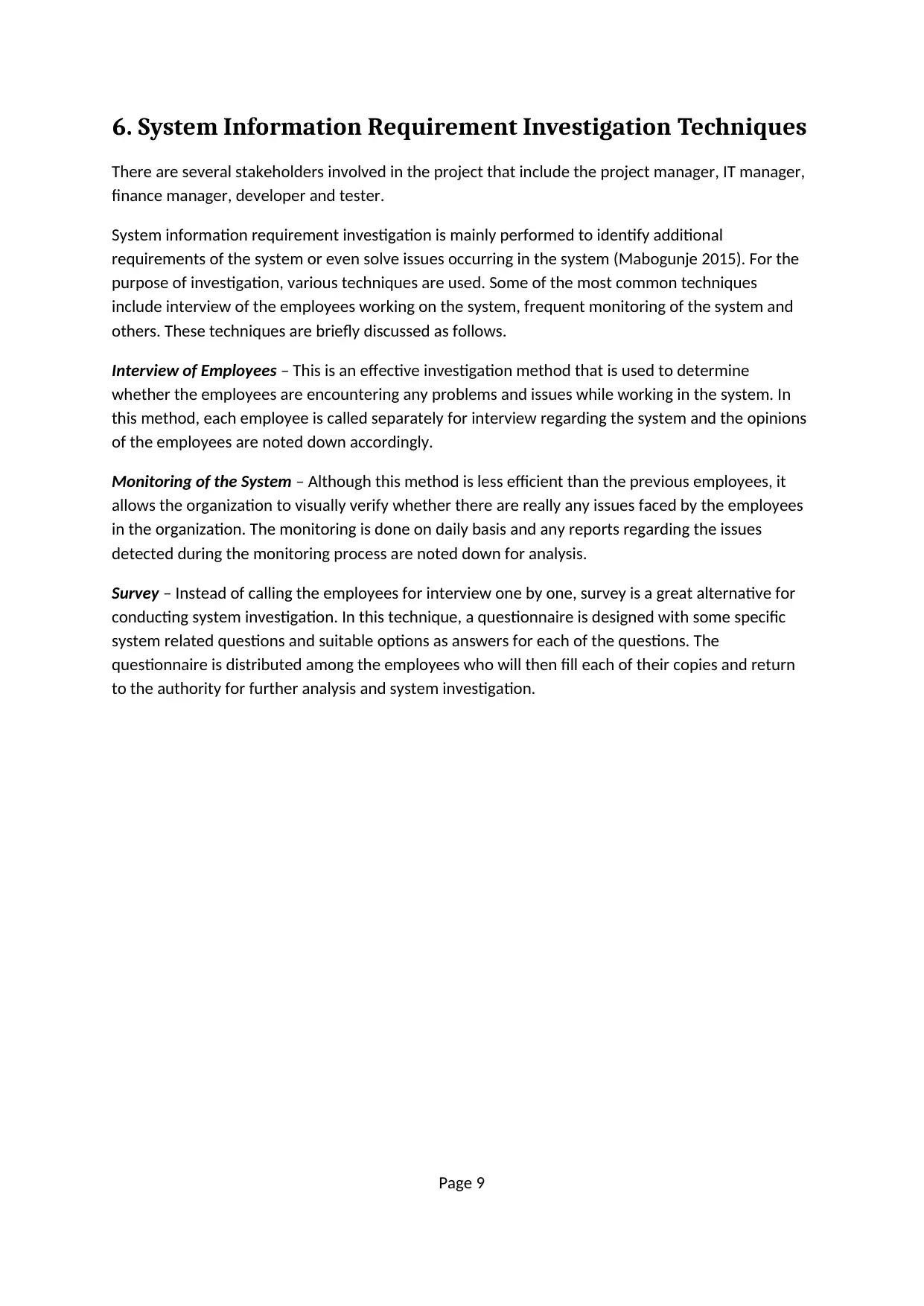
6. System Information Requirement Investigation Techniques
There are several stakeholders involved in the project that include the project manager, IT manager,
finance manager, developer and tester.
System information requirement investigation is mainly performed to identify additional
requirements of the system or even solve issues occurring in the system (Mabogunje 2015). For the
purpose of investigation, various techniques are used. Some of the most common techniques
include interview of the employees working on the system, frequent monitoring of the system and
others. These techniques are briefly discussed as follows.
Interview of Employees – This is an effective investigation method that is used to determine
whether the employees are encountering any problems and issues while working in the system. In
this method, each employee is called separately for interview regarding the system and the opinions
of the employees are noted down accordingly.
Monitoring of the System – Although this method is less efficient than the previous employees, it
allows the organization to visually verify whether there are really any issues faced by the employees
in the organization. The monitoring is done on daily basis and any reports regarding the issues
detected during the monitoring process are noted down for analysis.
Survey – Instead of calling the employees for interview one by one, survey is a great alternative for
conducting system investigation. In this technique, a questionnaire is designed with some specific
system related questions and suitable options as answers for each of the questions. The
questionnaire is distributed among the employees who will then fill each of their copies and return
to the authority for further analysis and system investigation.
Page 9
There are several stakeholders involved in the project that include the project manager, IT manager,
finance manager, developer and tester.
System information requirement investigation is mainly performed to identify additional
requirements of the system or even solve issues occurring in the system (Mabogunje 2015). For the
purpose of investigation, various techniques are used. Some of the most common techniques
include interview of the employees working on the system, frequent monitoring of the system and
others. These techniques are briefly discussed as follows.
Interview of Employees – This is an effective investigation method that is used to determine
whether the employees are encountering any problems and issues while working in the system. In
this method, each employee is called separately for interview regarding the system and the opinions
of the employees are noted down accordingly.
Monitoring of the System – Although this method is less efficient than the previous employees, it
allows the organization to visually verify whether there are really any issues faced by the employees
in the organization. The monitoring is done on daily basis and any reports regarding the issues
detected during the monitoring process are noted down for analysis.
Survey – Instead of calling the employees for interview one by one, survey is a great alternative for
conducting system investigation. In this technique, a questionnaire is designed with some specific
system related questions and suitable options as answers for each of the questions. The
questionnaire is distributed among the employees who will then fill each of their copies and return
to the authority for further analysis and system investigation.
Page 9
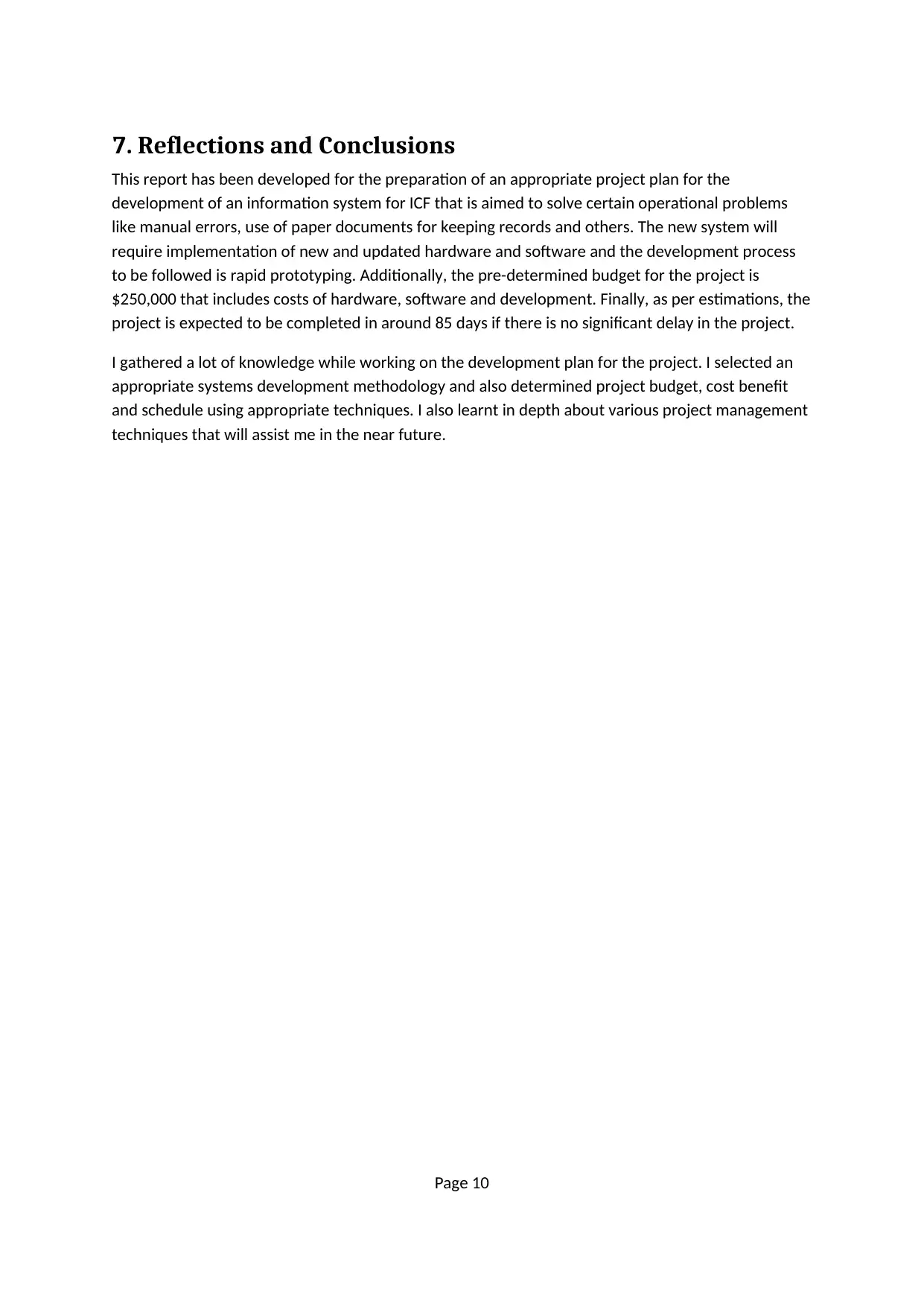
7. Reflections and Conclusions
This report has been developed for the preparation of an appropriate project plan for the
development of an information system for ICF that is aimed to solve certain operational problems
like manual errors, use of paper documents for keeping records and others. The new system will
require implementation of new and updated hardware and software and the development process
to be followed is rapid prototyping. Additionally, the pre-determined budget for the project is
$250,000 that includes costs of hardware, software and development. Finally, as per estimations, the
project is expected to be completed in around 85 days if there is no significant delay in the project.
I gathered a lot of knowledge while working on the development plan for the project. I selected an
appropriate systems development methodology and also determined project budget, cost benefit
and schedule using appropriate techniques. I also learnt in depth about various project management
techniques that will assist me in the near future.
Page 10
This report has been developed for the preparation of an appropriate project plan for the
development of an information system for ICF that is aimed to solve certain operational problems
like manual errors, use of paper documents for keeping records and others. The new system will
require implementation of new and updated hardware and software and the development process
to be followed is rapid prototyping. Additionally, the pre-determined budget for the project is
$250,000 that includes costs of hardware, software and development. Finally, as per estimations, the
project is expected to be completed in around 85 days if there is no significant delay in the project.
I gathered a lot of knowledge while working on the development plan for the project. I selected an
appropriate systems development methodology and also determined project budget, cost benefit
and schedule using appropriate techniques. I also learnt in depth about various project management
techniques that will assist me in the near future.
Page 10
⊘ This is a preview!⊘
Do you want full access?
Subscribe today to unlock all pages.

Trusted by 1+ million students worldwide
1 out of 13
Related Documents
Your All-in-One AI-Powered Toolkit for Academic Success.
+13062052269
info@desklib.com
Available 24*7 on WhatsApp / Email
![[object Object]](/_next/static/media/star-bottom.7253800d.svg)
Unlock your academic potential
Copyright © 2020–2025 A2Z Services. All Rights Reserved. Developed and managed by ZUCOL.





